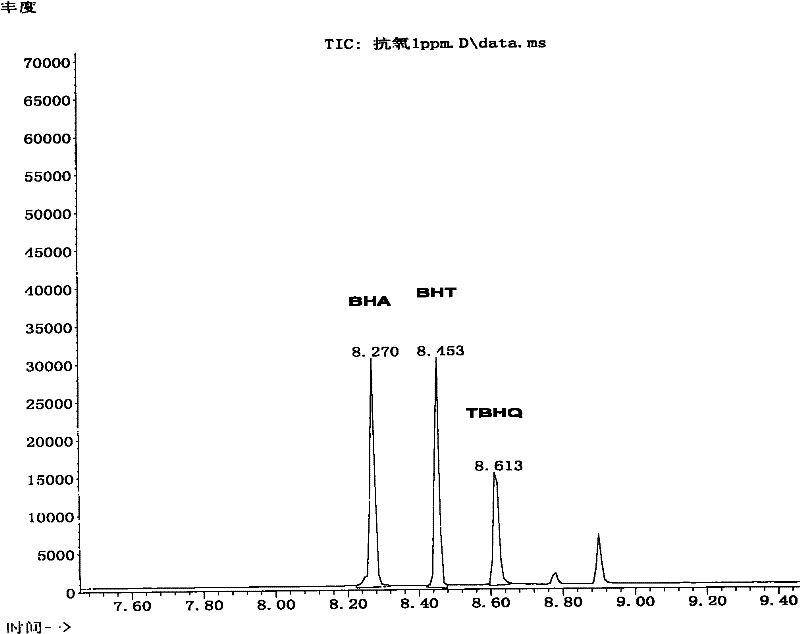Method for detecting antioxidant in food
A detection method and anti-oxidant technology, applied in the direction of measuring devices, instruments, scientific instruments, etc., can solve the problems of relatively strict test conditions, single detection target, cumbersome process, etc., and achieve simple and fast pre-treatment process, detection limit Low, high recovery effect
- Summary
- Abstract
- Description
- Claims
- Application Information
AI Technical Summary
Problems solved by technology
Method used
Image
Examples
Embodiment 1
[0033] Embodiment 1 linear equation and standard substance chromatogram
[0034] Using methanol as a solvent, prepare a series of standard solutions of BHA, BHT and TBHQ mixed solutions with concentrations of 0.1, 0.5, 1.0, 2.0, 5.0 μg / mL, respectively, and measure the peak area by injecting samples under the above chromatographic conditions. External standard method Quantitative. The chromatogram of the standard solution is as follows figure 1 , with the peak area y as the ordinate and the concentration x as the abscissa, a linear regression was performed, and the results are shown in Table 1.
[0035] The retention time of table 1 three kinds of antioxidants, monitoring ion, linear equation and correlation coefficient
[0036]
Embodiment 2
[0037] Example 2 extraction method optimization
[0038] 2.1 Selection of extraction solvent
[0039] Use 10mL of methanol and acetonitrile as extraction solvents to extract blank samples and standard samples, sonicate for 30 minutes, freeze to remove fat, and take the supernatant after centrifugation for direct instrumental analysis. The measurement results are shown in Table 2. It can be seen from Table 2 that the extraction effect of methanol is obviously better than that of acetonitrile, so methanol is selected as the extraction solvent.
[0040] Table 2 Extraction solvent selection experimental results
[0041]
[0042]
[0043] 2.2 Selection of extraction times
[0044] This experiment also compares the extraction effect of different extraction times, extracting 1, 2, and 3 times respectively, combining the extracts, and concentrating to a constant volume. The results are shown in Table 3. It can be seen from Table 3 that the effect of extracting twice is bett...
Embodiment 3
[0063] Antioxidant detection in embodiment 3 shortening
[0064] Use this method, GB / T 5009.30-2003, GB / T 23373-2009 to process the sample respectively.
[0065] This method: Weigh the shortening sample and weigh 2g ± 0.1g sample into a centrifuge tube, add 10mL methanol solution, because the sample oil sample is solid, ultrasonic extraction is required at 50°C for 30min, vortex and oscillate to mix evenly, and freeze in a -18°C refrigerator 2h. After taking it out, centrifuge it in a centrifuge at 5000r / min for 2min, take the supernatant into a concentrating bottle, add 10mL of methanol to the remaining residue, and repeat the above operation. Combine the two extracts, rotary evaporate to less than 10mL, dilute to 10mL with methanol, and analyze by gas chromatography-mass spectrometry.
[0066] GB / T 5009.30-2003: Weigh 2.00g of a uniformly mixed sample, put it into a 50mL beaker, add 30mL of petroleum ether to dissolve, transfer it to the chromatography column, add a small ...
PUM
 Login to View More
Login to View More Abstract
Description
Claims
Application Information
 Login to View More
Login to View More - R&D
- Intellectual Property
- Life Sciences
- Materials
- Tech Scout
- Unparalleled Data Quality
- Higher Quality Content
- 60% Fewer Hallucinations
Browse by: Latest US Patents, China's latest patents, Technical Efficacy Thesaurus, Application Domain, Technology Topic, Popular Technical Reports.
© 2025 PatSnap. All rights reserved.Legal|Privacy policy|Modern Slavery Act Transparency Statement|Sitemap|About US| Contact US: help@patsnap.com



